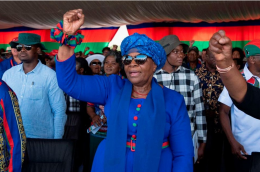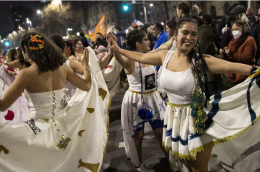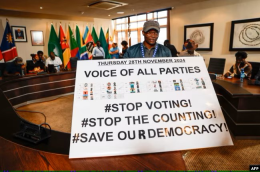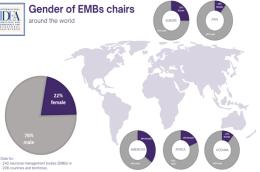Elections
Main navigation
There’s a question that has consistently gripped Botswana’s politics: bomme ba kae? (where are the women?). It became even more urgent with the country’s 2024 general elections.
Only 28 women stood for parliament out of 258 contestants, representing 10.85%. Only three women won their seats. This represents 4.92% of the 61 seats. It’s a drop from 5.26% in the 2019 elections.
In Botswana, women make up 54% of the eligible voters. Yet few occupy the corridors of power, where decisions and policies that affect them are made.
The country has been praised for being a model democracy. One of the reasons is that it has held regular elections since independence in 1966.
There are, however, flaws in Botswana’s democracy. One is that women are woefully under-represented in government.
I am a scholar of public policy in southern Africa. I am also a proponent of equal representation of women, who are a marginalised majority. In my research I argue that women’s limited participation hinders the consolidation of democracy.
Read here the full article published by The Conversation on 13 December 2024.
Image by The Conversation
What you need to know:
-
In a historic moment for African politics, Ghana elected its first female vice-president and Namibia elected its first female president, joining Tanzania's Samia Suluhu Hassan in the continent's apex female leadership.
-
Both leaders bring impressive credentials to their roles - Opoku-Agyemang as a former university vice-chancellor and education minister, and Nandi-Ndaitwah with over 25 years in senior public offices.
-
While these appointments mark significant progress for gender equality in African politics, challenges remain as evidenced by the low representation of women in Ghana's cabinet and parliament, though Namibia shows better progress with 44.2% women parliamentarians.
The year draws to a close with two momentous political achievements in Africa. On December 7, Ghana re-wrote history by electing its first ever female vice president in Prof Naana Jane Opoku-Agyemang, as running mate of former President John Dramani Mahama, now president elect, under the National Democratic Congress which won with 56.55 percent of the votes.
Read here the full article published by The Nation Africa on 18 December 2024.
Image by The Nation Africa
Ahead of 2024, political experts and commentators were calling this “the year of democracy”. It was deemed a “make or break year”, as around 1.5 billion people went to the polls in more than 50 countries, which held significant elections.
For women, who are already underrepresented in global politics, there were some critical victories and losses.
Based on statistics from UN Women alongside current election updates, Women’s Agenda has calculated there are 30 countries where 31 women serve as Heads of State and/or Government. Just 20 countries have a woman Head of State, and 17 countries have a woman Head of Government.
At the current rate, gender equality in the highest positions of power will not be reached for another 130 years.
As authoritarianism is on the rise worldwide as well, national elections grappled with challenges involving voter participation, free speech, and electoral independence.
Here’s a look back at some of this year’s most influential election results for women.
Read here the full article published by the Women’s Agenda on 16 December 2024.
Image by Women’s Agenda
This has been a historic electoral year, with more than 1.6 billion citizens called to cast their votes in 2024. In more than 70 countries, people have decided the political path of their nations. Yet we end this cycle with the sense that democracy is more threatened than ever.
There is an undeniable disconnect between citizens and their leaders. The scepticism and lack of trust should not surprise us. We are not leaving an easy world behind, especially for younger generations. Climate breakdown, the lack of economic opportunities, social injustice, the global housing crisis – these challenges have steadily eroded the democratic ideal. As a result, our societies are facing a wave of distrust in democratic institutions, particularly among younger citizens.
This scenario highlights a fundamental issue many governments face: is it possible that representative democracy has stopped representing us?
There is one area where the numbers speak for themselves, and the message isn’t a positive one. Globally, less than 30% of parliamentary seats are held by women, and fewer than 30 countries are led by women. While these figures are better than in previous years, they still reflect a chronic problem; at this pace, it would take us roughly 130 years to achieve gender equality.
To put this into perspective, a plastic bag takes about 100 years to decompose. If we were to use one today, it would vanish from this planet before democracies achieve gender parity. Gender isn’t the only example of the disconnect between politics and people, but it is a particularly stark one: how can our system of representation neglect half of the people it is meant to represent?
Read here the full article published by The Guardian on 6 December 2024.
Image by Guardian
Voting began on Friday morning in Ireland's general election amid a tight race between the incumbent coalition parties and the opposition party Sinn Fein.
The polls opened at 7 a.m. (0800 CET) and are scheduled to close at 10 p.m.
The ballot will see a total of 174 seats of the lower chamber of parliament — the Dail — being filled, which is more than ever before.
Over 3 million voters are registered to cast their ballot in an election that has been focused on the country's cost-of-living and housing crises, the response to an uptick in immigration, and economic management for potential future trade shocks.
Which parties are contesting?
Opinion polls put the country's three big parties — center-right Fine Gael and Fianna Fail, and the leftist-nationalist Sinn Fein — each at around 20%.
Fine Gael and Fianna Fail — two parties that came up from opposing sides of the Irish civil war in the 1920s — set aside a nearly century-old rivalry and agreed to share power after the general election in 2020 saw an inconclusive result.
Read here the full article published by DW News on 29 November 2024.
Image by DW News
WINDHOEK, NAMIBIA — Namibia extended voting for a second time Thursday with the opposition crying foul after logistical failures prevented many people from casting their ballots in the closely fought election.
With the ruling party facing its strongest challenge yet, opposition parties called for a halt to the vote counting and said they had lost confidence in the process.
The polls are a key test for the liberation-era South West Africa People's Organization party that has governed the mineral-rich country since independence 34 years ago. But SWAPO is being challenged by a younger generation of voters frustrated by high unemployment and enduring inequalities.
About 1.5 million people in the sparsely populated desert nation were registered to vote in Wednesday's presidential and legislative elections.
Many were still in line when polls were scheduled to close at 9 p.m. Wednesday, some saying they were in line for 12 hours.
The Electoral Commission of Namibia kept some polling stations open overnight into Thursday and allowed others to begin ballot counting.
Read here the full article published by the Voice of America on 28 November 2024.
Image by Voice of America











